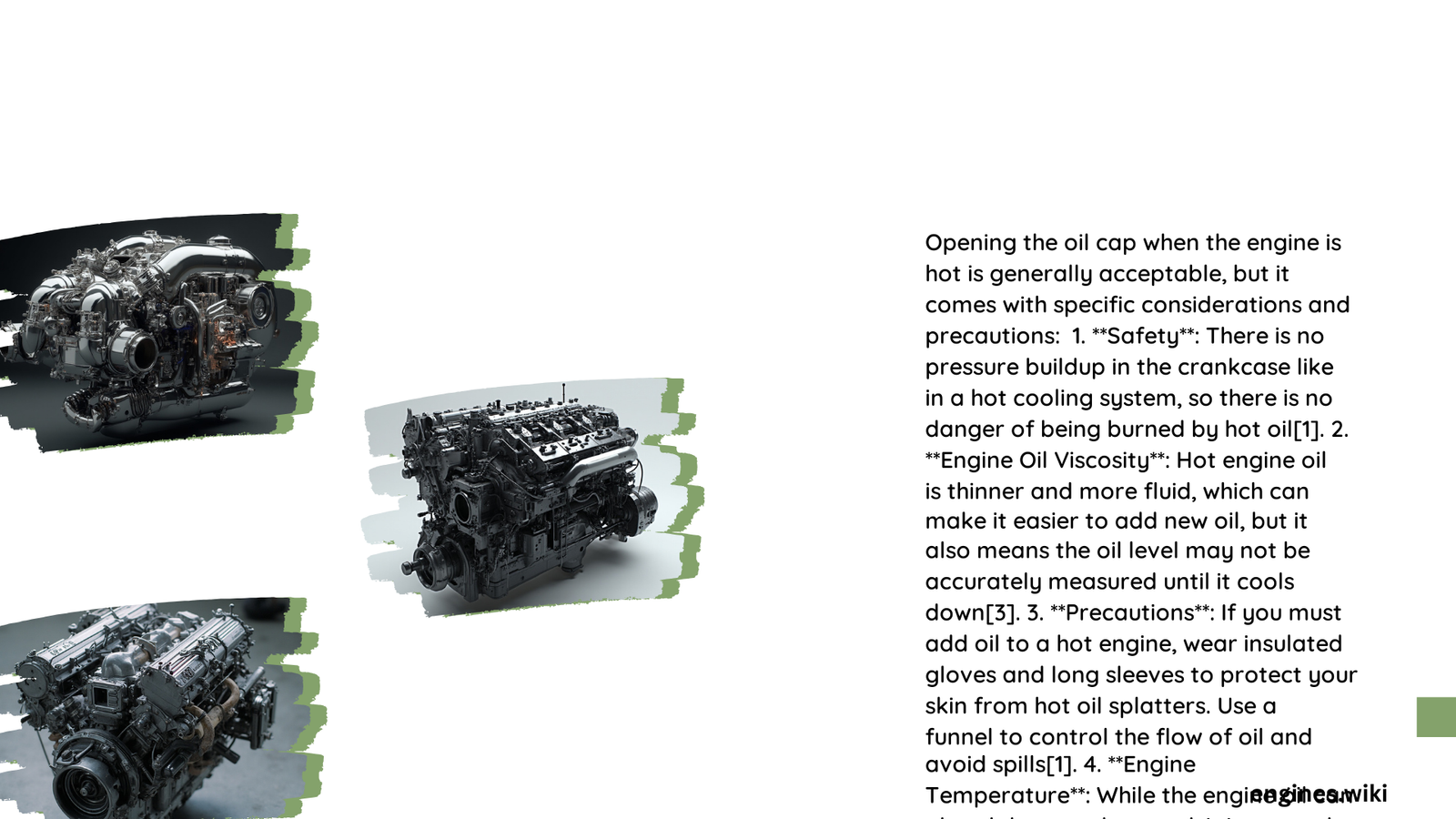Opening the oil cap on a hot engine is generally not recommended due to safety and mechanical concerns. The high temperatures can cause burns, and the sudden release of pressure may lead to oil splatter. While it’s possible to open the cap cautiously, it’s best to wait for the engine to cool down. This article explores the risks, precautions, and best practices for handling oil caps on hot engines.
What Are the Risks of Opening an Oil Cap on a Hot Engine?
Opening an oil cap when the engine is hot poses several risks:
- Burns from hot surfaces
- Oil splatter due to pressure release
- Potential thermal shock to engine components
- Reduced oil lubrication due to foaming
Why Is the Oil Cap Hot?
The oil cap becomes hot because:
- Engine oil circulates through hot engine components
- Heat transfer from surrounding engine parts
- Prolonged engine operation at high temperatures
How Hot Is Too Hot for Opening an Oil Cap?

There’s no specific temperature threshold, but consider these factors:
- Engine oil typically runs hotter than coolant
- Coolant temperatures usually range from 200°F to 220°F
- Oil temperatures can exceed these values
| Engine Component | Typical Temperature Range |
|---|---|
| Coolant | 200°F – 220°F |
| Engine Oil | 220°F – 250°F (or higher) |
What Precautions Should I Take When Opening a Hot Oil Cap?
If you must open the oil cap while the engine is hot:
- Wait at least 10-15 minutes for partial cooling
- Wear insulated gloves and long sleeves
- Use a cloth or rag to protect your hand
- Open the cap slowly to release pressure gradually
- Be prepared for potential oil splatter
How Can I Safely Check Oil Levels on a Hot Engine?
To safely check oil levels:
- Park on a level surface
- Turn off the engine and wait 5-10 minutes
- Locate the dipstick and remove it
- Wipe it clean, reinsert, and remove again
- Check the oil level against the markings
What Are the Potential Consequences of Opening a Hot Oil Cap?
Opening a hot oil cap can lead to:
- Severe burns from hot oil or metal surfaces
- Engine damage due to thermal shock
- Reduced oil effectiveness from foaming
- In extreme cases, oil ignition and engine fires
How Does Engine Temperature Affect Oil Viscosity?
Engine temperature significantly impacts oil viscosity:
- Hot oil becomes thinner (lower viscosity)
- Cold oil is thicker (higher viscosity)
- Optimal oil temperature ensures proper lubrication
When Is the Best Time to Check or Add Oil?
The ideal time to check or add oil is:
- When the engine is cool or slightly warm
- After the car has been parked for at least 15 minutes
- Before starting the engine in the morning
What Should I Do If I Must Open the Oil Cap on a Hot Engine?
If it’s absolutely necessary:
- Let the engine idle for a few minutes to reduce temperature
- Turn off the engine and wait as long as possible
- Use proper protective gear (gloves, long sleeves)
- Open the cap very slowly, allowing pressure to release
- Be prepared to quickly close the cap if oil starts to spray
How Can I Prevent Needing to Open the Oil Cap When Hot?
To avoid this situation:
- Regularly check oil levels when the engine is cool
- Address any oil leaks promptly
- Follow manufacturer-recommended oil change intervals
- Use the correct oil grade for your vehicle
What Are the Signs of Low Oil in a Hot Engine?
Signs of low oil in a hot engine include:
- Oil pressure warning light
- Engine overheating
- Unusual engine noises (knocking or ticking)
- Burning smell
How Does Hot Oil Behave Differently from Cold Oil?
Hot oil characteristics:
- Lower viscosity (thinner consistency)
- Potentially foams when agitated
- May carry more suspended particles
- Can release more vapors
What Tools Can Help Safely Handle Hot Oil Caps?
Useful tools include:
- Heat-resistant gloves
- Long-handled pliers or cap wrench
- Funnel with extended neck
- Oil absorbent mats or pads
How Does Engine Design Affect Oil Cap Temperature?
Engine design factors:
- Location of the oil cap (proximity to hot components)
- Presence of heat shields or insulation
- Oil circulation patterns within the engine
- Overall engine cooling efficiency
By understanding these aspects of handling hot oil caps, you can make informed decisions about engine maintenance and safety. Always prioritize caution when dealing with hot engine components, and when in doubt, wait for the engine to cool down before performing any checks or maintenance.
Reference:
1. https://www.crossroadshelpline.com/blog/hot-engine/
2. https://www.crossroadshelpline.com/blog/add-oil-to-a-hot-engine/
3. https://www.carparts.com/blog/can-you-put-oil-into-a-hot-engine/
